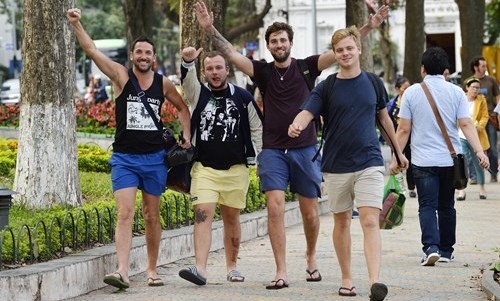Many essential policies for tourism development
According to report by Ministry of Culture, Sports and Tourism, the Vietnamese tourism sector welcomed 13 million international and 73.2 million domestic tourists in 2017, earning 510.9 trillion VND.
 |
| Viet Nam welcomed 13 million international visitors in 2017. |
The number of international visitors and domestic tourists increased by 30% (3 million) and 18% (11.2 million) compared to last year, while the total revenue of the tourism sector was up 27.7% (110.9 trillion VND). Notably, Vietnamese tourism received the appreciation and recognition of international organisations. The country ranked 6th among the 10 destinations with fastest development in the world; Vietravel Company was named the World's Leading Group Tour Operator 2017 at the World Travel Awards 2017 (WTA); and the InterContinental Danang Sun Peninsula Resort was voted as the ‘Best Luxury Resort Worldwide’.
In addition, the 2017 APEC High-Level Declaration on tourism which is themed ‘Promoting Sustainable Tourism for an Inclusive and Interconnected Asia-Pacific’ was approved to encourage long-term and feasible economic contributions, bringing benefits to relevant sides among the APEC community. This creates competitive environment and supports all tourism businesses, particularly micro, small and medium-sized enterprises; and takes full advantage of the changes from new advanced technologies.
The above achievements were mainly attributed to the drastic and essential policies by the Party and State. On January 16, 2017, the Politburo issued the Resolution No 08-NQ/TW on developing tourism into a spearhead economic sector. The 3rd session of the 14th National Assembly adopted the 2017 Tourism Law. These policies have set out strategic development directions for the country, particularly the tourism sector as well as promoted the innovation thinking in developing tourism under the market economy laws, creating a legal corridor and clearing resources for the development of tourism.
The policies have been gradually implemented by the tourism sector and relevant agencies, bringing some positive changes. In 2017, a large number of enterprises were mobilised to participate in the tourism promotion, while popular channels were diversified through the internet and social networks. The issuance of e-visa and reform of the entry procedure towards a more simple system have created favourable conditions for visitors; meanwhile the tourism infrastructure has been upgraded, contributing to improving the quality of service. Cultural and heritage tourism forms have been increasingly fully tapped as a special strength, attracting numerous international friends.
The tourism sector’s achievements this year are very encouraging. However, it is straightforward to admit that Vietnamese tourism still has many shortcomings and weaknesses, such as a lack of seriousness in planning leading tourist destinations, causing disorder and breaking the natural beauty and environment of many coastal areas and national tourism areas. In addition, a shortage of tourist accommodations and special tourism products as well as human resources serving for the sector is one of limitations of the country’s tourism sector. Therefore, it is essential to drastically implement projects to restructure tourism, considering as a core measure to maintain sustainable growth.
(Source: NDO)